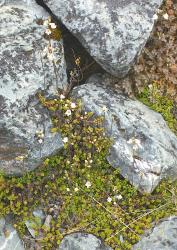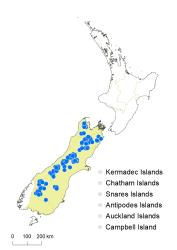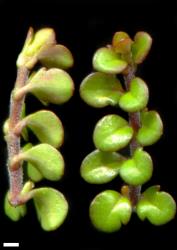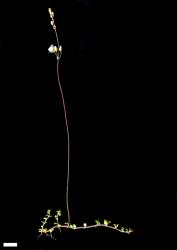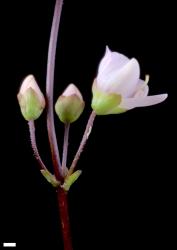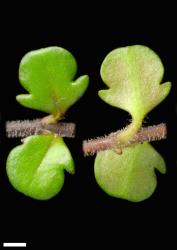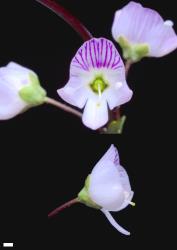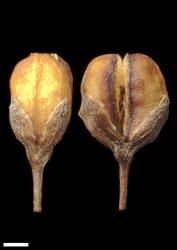- ≡ Parahebe decora Ashwin in Allan, Fl. New Zealand 1, 877, 974 (1961)
- = Veronica bidwillii Auctt. nom. illeg., non Veronica ×bidwillii Hook. 1852
Mat-forming sub-shrub to 0.03 m tall. Stems prostrate or decumbent, eglandular-pubescent; hairs usually uniform, rarely bifarious. Leaf bud indistinct, leaves separating while very small, opposite-decussate, spreading to recurved, separating early; lamina coriaceous, obovate to orbicular or lyrate, 1.5–5.0 mm long, 1–5 mm wide, glossy green, dark green, red-tinged, or bronze above, dull pale green or pinkish beneath, midrib evident, at least basally; surfaces usually glabrous, rarely with a few eglandular hairs especially when young; margin usually glabrous, rarely ciliate, usually crenate or lobed at base, sometimes entire, lobes in 1–2 pairs; apex rounded; base cuneate; petiole 0.5–1.5 mm long. Inflorescence a lateral raceme, 60–250 mm long; flowers distant, 8–20 or rarely fewer, all bisexual; bracts alternate, the lowest usually in a whorl of 3, lanceolate to elliptic, < pedicels. Pedicels erecto-patent to sub-erect, 2–10 mm long, glabrous or eglandular-hairy all around. Calyx lobes 4, acute to sub-acute, 2–3 mm long, sub-equal, mixed glandular- and eglandular-ciliolate. Corolla 6–12 mm diameter; tube white and yellow, 1 mm long, < calyx, eglandular-hairy inside; lobes 4, white or pink, sub-erect to spreading, unequal, linear to orbicular, 3.5–6.0 mm long, rounded; nectar guides magenta, on posterior and sometimes on lateral lobes. Stamen filaments white, 3–5 mm long; anthers white or pink or magenta. Style glabrous, 3–4 mm long. Capsules broadly angustiseptate, emarginate, glabrous, 4.0–4.5 mm long, 3–4 mm at widest point. Seeds ellipsoid to discoid, flattened, smooth, straw-yellow to brown, 0.7–1.0 mm long.
V. decora plants are usually easily distinguished from all other species by their prostrate, dark brown to almost black stems with antrorse, curved, uniform stem hairs, very small, glossy, rounded leaves with usually one pair of lobes, and stout, erect, long peduncles usually with the lowermost three flowers in a whorl.
South Island: Western Nelson, Marlborough, Westland (near the Main Divide), Canterbury, Otago, Southland.
Shingle river beds, screes, stony places in grassland, moraines. Recorded elevations range from 439 to 1554 m.
Garnock-Jones & Lloyd (2004) list specimens identified as hybrids, V. decora × lyallii. These two species have widely overlapping distributions, but different chromosome numbers. The hybrids have low pollen stainability. The name V. ×bidwillii Hook. applies to this hybrid.
Flowers: December to February, occasionally earlier; fruits: January to May.
2n = 40 (Frankel & Hair 1937, as V. bidwillii; Hair 1970, as P. decora).
Veronica decora is classified in V. subg. Pseudoveronica sect. Hebe and informally in the “speedwell hebe” group (Albach & Meudt 2010). Speedwell hebes are characterised by short corolla tubes, nectar guides on the corolla, and rather lax inflorescences. Flowers of most speedwell hebes, including V. decora, have plicate, lateral corolla lobes, which enfold the stamens.



